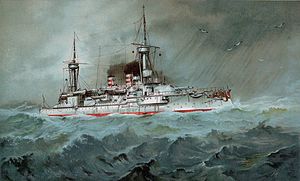SMS Wörth

1902 lithograph of Wörth
|
|
| History | |
|---|---|
|
|
|
| Name: | Wörth |
| Builder: | Germaniawerft, Kiel |
| Laid down: | May 1890 |
| Launched: | 6 August 1892 |
| Commissioned: | 31 October 1893 |
| Fate: | Scrapped in 1919 |
| General characteristics | |
| Class and type: | Brandenburg-class battleship |
| Displacement: | 10,670 t (10,500 long tons) |
| Length: | 115.7 m (379 ft 7 in) |
| Beam: | 19.5 m (64 ft 0 in) |
| Draft: | 7.6 m (24 ft 11 in) |
| Installed power: | 12 coal-fired water-tube boilers, 10,089 ihp (7,523 kW) |
| Propulsion: | 2-shaft triple expansion engines |
| Speed: | 16.9 knots (31.3 km/h; 19.4 mph) |
| Range: | 4,300 nmi (8,000 km; 4,900 mi) at 10 knots (19 km/h; 12 mph) |
| Complement: |
|
| Armament: |
|
| Armor: | |
SMS Wörth ("His Majesty's Ship Wörth") was one of four German pre-dreadnought battleships of the Brandenburg class, built in the early 1890s. The class also included Brandenburg, Kurfürst Friedrich Wilhelm, and Weissenburg. The ships were the first ocean-going battleships built by the Kaiserliche Marine (Imperial Navy). Wörth was laid down at the Germaniawerft dockyard in Kiel in May 1890. The ship was launched on 6 August 1892 and commissioned into the fleet on 31 October 1893. Wörth and her three sisters were the only battleships of their time to carry six heavy guns rather than four. She was named for the Battle of Wörth fought during the Franco-Prussian War of 1870–71.
Wörth served in the German fleet for the first decade of her career, participating in the normal peacetime routine of training cruises and exercises. She took part in the German naval expedition to China in 1900 to suppress the Boxer Rebellion, though by the time the fleet arrived the siege of Peking had already been lifted, and Wörth saw little direct action in China. She was placed in reserve in 1906 as newer, more powerful vessels had supplanted the Brandenburg class as front-line battleships. Obsolete by the start of World War I, Wörth and Brandenburg served in a limited capacity in the Imperial German Navy as coastal defense ships for the first two years of the war, though they did not see action. By 1916, Wörth was reduced to a barracks ship, a role in which she served until the end of hostilities. Despite plans to convert her into a freighter after the war, Wörth was scrapped in the port of Danzig in 1919.
...
Wikipedia
